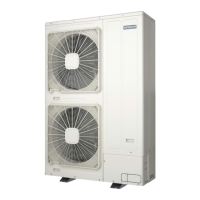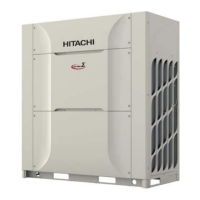9 Electrical and control settings
Optional indoor unit wiring (accessories)
TCGB0123 rev.2 - 10/2019
115
9
Mark Part name Description
TERMINAL BOARD 1 (TB1)
N
1~ 230V 50Hz
3N~ 400V 50Hz Main power supply connection
L1
L2
-
L3
TERMINAL BOARD 2 (TB2)
1
H-LINK commutation
The H-LINK transmission has to be done between the indoor unit and the terminals 1-2 of
either outdoor unit, ATW-RTU (except ATW-RTU-04) or any other central device.
2
3
H-LINK communication for
remote control switch
Terminals for the connection of the YUTAKI unit controller.
4
5 DHW tank’s thermistor The DHW sensor is used to control the temperature of the domestic hot water tank.
6 Common thermistor Common terminal for thermistor.
7
Thermistor for water outlet
temperature of second cycle
The sensor is used for the second temperature control and should be positioned after the
mixing valve and the circulation pump.
8
Thermistor for water outlet
temperature after hydraulic
separator
Water sensor for hydraulic separator, buffer tank or boiler combination.
9 Common thermistor Common terminal for thermistors.
10
Thermistor for swimming pool
water temperature
The sensor is used for the swimming pool temperature control and should be positioned
inside plate heat exchanger of the swimming pool.
11
Thermistor for second ambient
temperature
The sensor is used for the second ambient temperature control and it should be positioned
outdoors.
YUTAKI M (R410A) / YUTAKI S / YUTAKI S COMBI: 4-20 mA application (Not used)
12
YUTAKI M (R32): Earth
Earth connection for the 3 way valve and water pump
NEW
YUTAKI M (R410A) / YUTAKI S / YUTAKI S COMBI: 4-20 mA application (Not used)
13 Common line Terminal Line common for input 1 and input 2.
14 Input 1 (Demand ON/OFF) (*)
The air to water heat pump system has been designed to allow the connection of a remote
thermostat (HITACHI offers the room thermostat ATW-RTU-04 as accessory) to effectively
control your home’s temperature. Depending on the room temperature, the thermostat will
turn the air to water heat pump system ON and OFF.
15 Input 2 (ECO mode) (*)
Available signal which allows to reduce the water setting temperature of circuit 1, circuit 2
or both.
16 Common line Terminal Line common for inputs 3, 4, 5, 6, 7.
17 Input 3 (Swimming pool) (*)
Only for swimming pool installations: It is necessary to connect an external input to the air
to water heat pump to provide signal when the water pump of swimming pool is ON.
18 Input 4 (Solar) (*) Available input for Solar combination with Domestic Hot Water Tank.
19 Input 5 (Smart function) (*)
For the connection of an external tariff switch device to switch OFF the heat pump during
peak electricity demand period. Depending on the setting, the heat pump or DHWT will be
blocked when signal is open/closed.
20 Input 6 (DHW boost) (*) Available input for an instantaneous heating of the domestic hot water of the tank.
21 Input 7 (Power meter)
The measuring of the real power consumption can be done connecting an external power
meter. The number of pulses of the power meter is a variable which must be set. By this,
every pulse input is added into corresponding operation mode (Heating, Cooling, DHW
Operation). Two possible options:
- One power meter for all installation (IU+OU).
- Two separated power meters (one for IU and one for OU).
22
Aquastat security for circuit 1
(WP1)
Terminals intended for the connection of the Aquastat security accessory (ATW-AQT-01)
for controlling water temperature of the circuit 1.
23
24(C) Mixing valve close
When a mixing system is required for a second temperature control, these outputs are
necessary to control the mixing valve.
25(O) Mixing valve open
26(N) N Common
27(L) Water Pump 2 (WP2)
When there is a second temperature application, a secondary pump is the circulating
pump for the secondary heating circuit.

